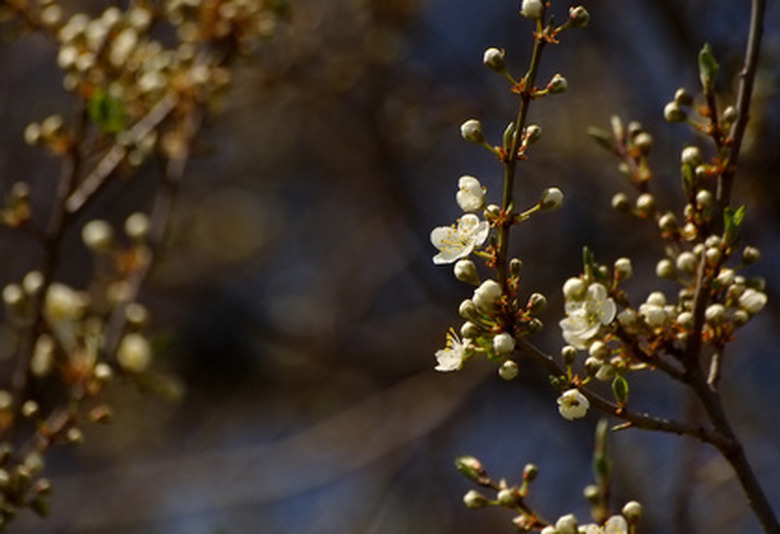What Is A Wild Plum Tree?
The wild plum tree is native to America, according to North Carolina State University. In fact, it is commonly called the "American" plum tree. This deciduous tree (the leaves drop off the tree in autumn) produces edible plums, although they are a lot smaller than those you would generally find at a supermarket. The scientific name for the tree is Prunus Americana.
Appearance
Wild plum trees are small, multi-trunked trees. They can grow to a maximum height and width of 20 feet, according to the University of Florida, and often appear more like a shrub. The branches of the tree are thin and covered with long thorns that grow up to 3 inches. Wild plum trees bloom in the spring with a profusion of small, white flowers, making them highly desirable for home gardeners who want a showy spring ornamental. The leaves are between 1 and 2 inches long and are a true green color. In the fall, the foliage of the tree changes from green to gold.
- The wild plum tree is native to America, according to North Carolina State University.
- This deciduous tree (the leaves drop off the tree in autumn) produces edible plums, although they are a lot smaller than those you would generally find at a supermarket.
Fruit
Wild plum trees produce fruit that is popular with animals and people, according to the University of Florida. The fruit of the tree averages a half-inch in diameter. The plums are bright red at first and become yellow upon ripening, which happens in July. They can be eaten fresh from the tree and are commonly used to make jellies and jams.
Location and Climate
Wild plums, like the name implies, are often found growing in the wild in the central and eastern parts of the United States, according to the University of Connecticut. These trees are cold hardy to United States Department of Agriculture (USDA) growing zone 3, depending on the cultivar. Most grow best in USDA zones 5 through 8. Tropical areas are too warm for this tree.
- Wild plum trees produce fruit that is popular with animals and people, according to the University of Florida.
Culture
Prunus Americana is a hardy tree that can grow in all types of soil and is drought-tolerant. It is so hardy, in fact, that it thrives even when neglected, according to North Carolina State University. For that reason, it is often planted along medians, in parking lots or in other areas where it may not be tended on a regular basis. This tree grows best in full sun or partial shade and makes an excellent specimen, container or patio tree due to its compact size.
Problems
Wild plum trees often suffer from tent caterpillars, which can cover the tree with their webs and defoliate it (eat all the leaves). Spraying the tree with an insecticide at the first sign of caterpillar activity may reduce the infestation. These trees also produce a large amount of suckers (branches that grow from the roots of the tree), which should be pruned off immediately. Finally, the thorns can be a concern, especially if young children play around the tree.
- Prunus Americana is a hardy tree that can grow in all types of soil and is drought-tolerant.
- These trees also produce a large amount of suckers (branches that grow from the roots of the tree), which should be pruned off immediately.
